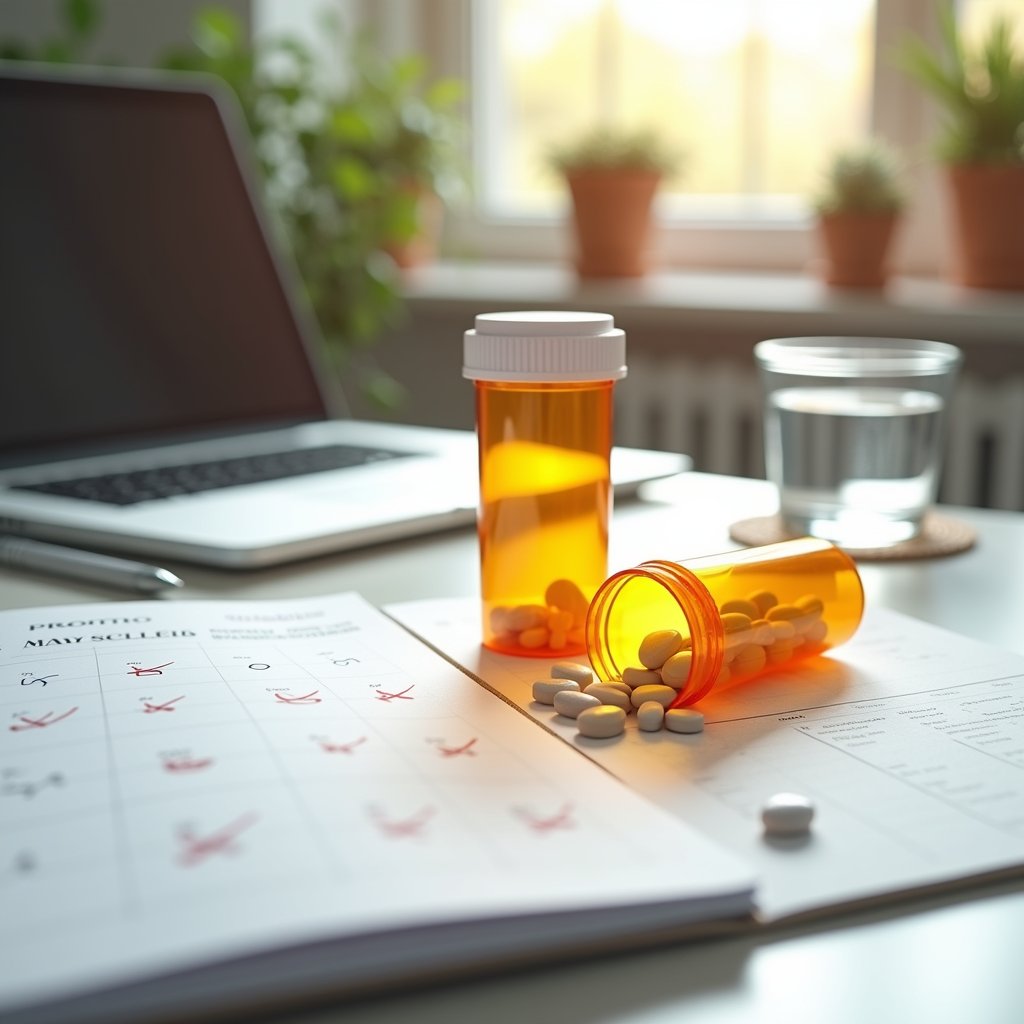Long-term Suboxone treatment requires a minimum 6-month commitment for ideal recovery success. You’ll need consistent medication management, starting with 16mg/4mg doses that your provider will adjust based on your response. While medication alone can work, you’ll achieve 75% higher retention rates by combining it with therapy, peer support groups, and family involvement. Understanding the full scope of treatment options and support resources will strengthen your recovery pathway.
Understanding Optimal Treatment Duration

When determining the ideal duration for Suboxone treatment, medical providers must consider multiple clinical factors rather than adhering to a fixed timeline. You’ll find that medication escalation patterns typically begin with a 1-3 day induction phase, followed by dose adjustment timelines spanning 2-4 weeks for stabilization.
Research shows that treatment lasting less than six months considerably increases your relapse risk. While maintenance doses usually range from 2-24mg, your specific needs will depend on factors like the type of opioids used, addiction severity, and co-occurring mental health conditions. You’ll need to wait 12-24 hours after your last opioid use before starting treatment. Having strong support networks may allow for a shorter overall treatment duration.
The FDA supports indefinite use when necessary, prioritizing your sustained recovery over arbitrary endpoints. Regular monitoring and behavioral therapy support remain essential throughout your treatment path.
Keys to Successful Dose Management

Successful dose management boils down to finding the perfect balance between withdrawal suppression and safety. You’ll typically start with adjustments during withdrawal, moving toward the standard target dose of 16 mg/4 mg buprenorphine/naloxone. Your healthcare provider will make incremental changes every 3-7 days based on your response. Buccal or sublingual administration methods are both acceptable for maintenance treatment.
Effective dose monitoring requires regular assessment of your symptoms and careful documentation of your patient adherence. While most people stabilize between 12-16 mg daily, you might need adjustments based on your specific needs. Starting at higher initial doses has been shown to reduce early treatment dropout. It’s essential to avoid benzodiazepines during treatment, as they drastically increase overdose risk.
Keep in mind that doses above 24 mg aren’t common, and there’s limited evidence supporting benefits beyond 32 mg. You’ll work with your provider to maintain the most effective dose for your long-term recovery.
Preventing Relapse During Recovery

Beyond maintaining the right medication dosage, preventing relapse requires an inclusive approach combining pharmacological and behavioral strategies. While Suboxone’s dual mechanism helps control cravings and deter misuse, you’ll need to develop thorough coping skills for long-term success. Medication alone can be effective treatment for opioid use disorder, though additional support services may enhance recovery outcomes.
Understanding that relapse is common in addiction recovery can help reduce shame and encourage patients to stay committed to their treatment plan. Start by addressing underlying trauma through therapy and identifying personal triggers that could compromise your recovery. You’ll work with clinicians to manage co-occurring conditions like depression or anxiety while cultivating self-care habits, including proper sleep hygiene and stress management techniques. CBT and mindfulness practices will help you reframe negative thought patterns and interrupt craving cycles.
Regular monitoring of your progress allows for timely adjustments to your treatment plan. Stay connected with support networks and maintain open communication with your healthcare team about any challenges you encounter.
Building a Strong Support System
A sturdy support system forms the cornerstone of successful Suboxone treatment, with evidence showing that patients who maintain strong therapeutic relationships and peer connections achieve 75% higher retention rates. You’ll need to focus on community integration through peer support groups, counseling sessions, and family involvement to optimize your recovery outcomes. Research consistently demonstrates that patients receiving comprehensive support show significant reduction in illicit opioid use during treatment.
Your support network should include clinicians who’ll guide your dosing adjustments, peers who understand your path, and family members educated about OUD recovery. Peer connections through 12-step programs and support groups provide vital accountability and practical strategies for managing treatment challenges. You’ll benefit from shared experiences and immediate emotional support during difficult moments. With over 50,000 practitioners registered to provide MAT services across the country, finding qualified medical support for your recovery journey has become increasingly accessible.
Navigating Common Treatment Challenges
Traversing Suboxone treatment comes with significant challenges that require strategic planning and persistence to overcome. You’ll need to address medication adherence barriers, including access limitations, insurance obstacles, and potential provider shortages especially if you’re in a rural area. Studies show that 50% of patients discontinue treatment within six months, making long-term commitment indispensable for success. Patients who receive comprehensive treatment plans that include therapy and peer support alongside medication show better recovery outcomes. Research indicates that West Coast patients have higher rates of sustained opioid use during treatment.
To maintain consistent progress, you’ll need to focus on promoting holistic wellbeing while adhering to prescribed dosing schedules. Higher doses correlate with better outcomes, yet many face restricted access due to state regulations and insurance policies. If you have a history of injection drug use, you may require additional support strategies. Be aware that continued illicit opioid use affects nearly 43% of patients post-treatment, emphasizing the importance of extensive care approaches.
Achieving Long-Term Recovery Goals
While pursuing long-term recovery through Suboxone treatment, you’ll find that extended duration considerably improves your chances of success. Research shows that continuous treatment beyond 6-9 months reduces your risk of hospitalization by 26% and cuts emergency visits markedly.
Studies indicate fewer days of opioid use over time with consistent medication-assisted treatment. The combination of buprenorphine and naloxone helps reduce both cravings and potential misuse.
When combined with lifestyle changes and proper medication alternatives, you’re positioned for ideal outcomes.
Your path to sustained recovery is supported by compelling evidence:
- You’ll experience a 173% lower overdose risk through consistent medication adherence
- Your chances of opioid-related hospitalizations drop by 128% with sustained treatment
- You’re likely to achieve stable abstinence within 3.5 years, with potential freedom from medication assistance
Maintaining higher initial doses and steady treatment engagement proves critical for your success, especially when paired with behavioral support and personalized dose adjustments throughout your recovery path.
Personalizing Your Treatment Journey
Your successful recovery with Suboxone begins with finding the precise dose that effectively manages withdrawal symptoms while minimizing side effects.
Combining Suboxone with comprehensive support services significantly improves treatment outcomes and long-term success rates.
The long half-life of buprenorphine provides steady relief throughout your treatment journey without frequent dosing adjustments.
Treatment is enhanced through FDA-approved medications combined with behavioral therapies to address both physical and psychological aspects of opioid addiction.
As your treatment progresses, you’ll work closely with healthcare providers to adjust your medication and therapeutic approaches based on your changing needs and response to treatment.
You’ll also need to establish strong support networks through peer groups, counseling, and community resources that can sustain your long-term recovery goals.
Finding Your Ideal Dose
Finding the ideal Suboxone dose requires careful calibration during the preliminary induction phase, typically starting with 4-8 mg of buprenorphine on day one. Your healthcare provider will guide your individualized dose titration, monitoring for dose related side effects while adjusting to reach optimal therapeutic levels, usually 12-16 mg daily.
You’ll work closely with your provider to find the precise dose that controls withdrawal symptoms without causing drowsiness. Your treatment plan will evolve based on your unique physiological response and recovery progress. You’ll need regular check-ins during the initial weeks to maintain your dose remains effective. The medication is available in film or tablet forms to accommodate different patient preferences and dosing needs.
Most patients stabilize on 16 mg/4 mg daily, though some may require up to 24 mg/6 mg. Your maintenance dose will be determined by your specific needs, withdrawal symptoms, and long-term treatment goals.
Adapting Treatment Over Time
Successful Suboxone treatment requires ongoing adjustments to meet your changing therapeutic needs throughout recovery. Your healthcare provider will closely monitor your response, gradually adjusting your dose to optimize effective withdrawal management while minimizing side effects. Regular medical evaluations help identify when modifications are necessary.
Managing medication interactions is vital during long-term treatment. If you’re taking other medications, particularly benzodiazepines, your doctor will carefully coordinate your care. You’ll need to maintain consistent dosing schedules, whether once or twice daily, to keep opioid receptors stable and reduce cravings.
While buccal administration might work better for some patients than sublingual delivery, your provider will determine the most effective method for you. Keep in mind that medication adherence remains essential for preventing relapse, especially during stressful periods in your recovery path.
Building Recovery Support Networks
Building a sturdy recovery support network involves three critical components: evidence-based medication, professional healthcare guidance, and community-based resources. You’ll need to carefully integrate these elements while considering options like family counseling and faith-based programs that align with your values and circumstances.
Your personalized support network should include:
- Medical professionals who can monitor your Suboxone treatment and adjust dosing based on your progress
- Peer recovery groups or coaches who understand the unique challenges of opioid recovery
- Cultural and community resources that address your specific needs, whether through telehealth services or local support systems
Research shows that patients who maintain consistent engagement with multiple support channels achieve better long-term outcomes. Don’t hesitate to combine traditional treatment approaches with complementary support services that resonate with your recovery path.
Frequently Asked Questions
Can I Travel Internationally While Taking Suboxone?
Yes, you can travel internationally with Suboxone, but you’ll need proper documentation. Carry your prescription, a doctor’s letter, and keep medications in their original packaging to address airport security concerns.
Follow medication storage guidelines by packing your supply in carry-on luggage and declaring it at checkpoints. Research your destination country’s laws, as regulations vary. Contact embassies beforehand and guarantee you don’t exceed the recommended 90-day supply limit.
How Does Suboxone Interact With Dental Procedures and Local Anesthesia?
While Suboxone generally doesn’t interfere with basic dental procedures, you’ll need to inform your dentist about your medication to adjust anesthesia dosing appropriately. Local anesthetics are safe, but you may require modified doses for effective pain control.
You should avoid dissolving Suboxone tablets directly against your teeth, as this can lead to dental complications like enamel erosion. Always rinse your mouth after taking Suboxone and maintain regular dental checkups to monitor oral health.
Will Suboxone Affect My Ability to Conceive or Pregnancy Outcomes?
Current research shows Suboxone doesn’t considerably impact your fertility or ability to conceive. You can safely continue treatment while trying to get pregnant and throughout pregnancy.
While fertility preservation strategies aren’t typically necessary, you should discuss breastfeeding considerations with your healthcare provider before delivery. Though your baby may experience mild withdrawal symptoms after birth, studies indicate Suboxone is safer during pregnancy than untreated opioid use disorder.
What Happens if I Need Emergency Surgery While on Suboxone?
If you need emergency surgery while on Suboxone, inform your medical team immediately about your medication. You’ll face unique emergency pain management challenges since Suboxone can block traditional pain medications’ effectiveness.
Your doctors may need to use higher doses of opioids or alternative pain control methods. They’ll closely monitor you for unexpected medication interactions and respiratory issues. Consider wearing a medical alert bracelet to guarantee healthcare providers know about your Suboxone use in emergencies.
Can I Switch Between Different Brands of Buprenorphine During Treatment?
Yes, you can switch between different buprenorphine brands during treatment, but you’ll need careful medical supervision. Your healthcare provider will make flexible dosage adjustments based on your response, as different formulations can have varying absorption rates.
Medication adherence monitoring is essential during the change to guarantee you’re not experiencing withdrawal symptoms. While most patients move over successfully, you may need temporary dose modifications to maintain stability. Always consult your doctor before making any changes.






